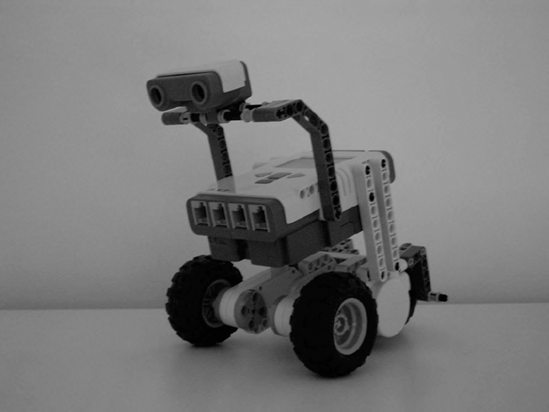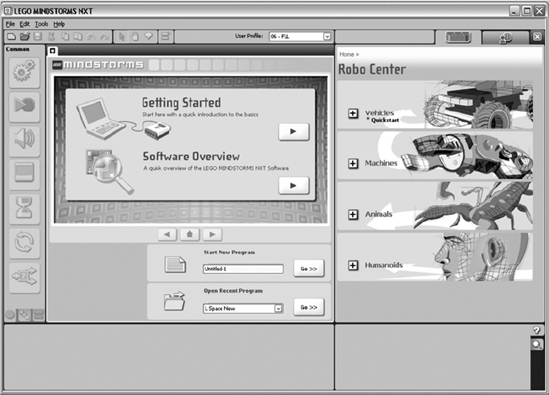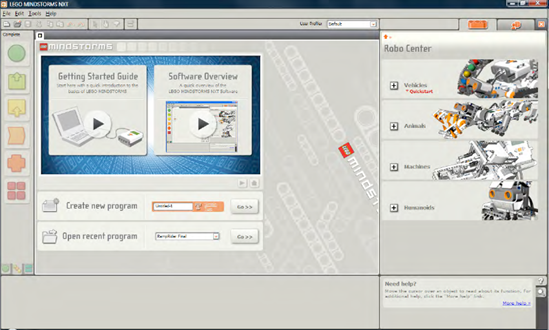If you are already familiar with the subject of robots and the concept of programming, feel free to skip ahead to the more in-depth chapters that start with Chapter 14. But, if you are just starting out with your LEGO Mindstorms NXT robotics kit and are asking yourself questions such as, "How is a robot different from a toaster?" or "Just what is this thing called programming?" then you're in the right place. If terms like conditional statements, nested loops, and variables make your head spin, don't worry—they make my head spin, too.
There is simply no reason that learning to use the Mindstorms NXT robotics kit should cause stress. It's supposed to be fun, right? Building robots and making them do what you want them to do shouldn't cause headaches. I don't like headaches, and I certainly don't want to give you one, so sit back and let me show you a less stressful method for getting the most out of NXT.
I'm going to keep this short—I promise. What is a robot? There are numerous definitions. One definition is a human-shaped mechanical device that mimics human actions. Another definition is an electronic machine that functions independently, without human control. And, there are many more. There truly doesn't seem to be one official definition.
For the purpose of this book, I'm going to give you my definition. Here goes: A robot is a device that is built to independently perform actions and interact with its surroundings.
In a nutshell, a robot should be able to move and react all on its own. If you are controlling its actions, it's just a remote-controlled toy, right? But if your device can do things like examine its surroundings, respond to obstacles such as chairs or walls, pick out a red ball from a mix of colored balls, and hundreds of other activities without help from its human creator, then you've got a robot.
You can build a robot using all the great Mindstorms NXT components that came with your robotics kit. Your bot can have claws or hands. It can have ears to listen and eyes to see. It can walk on legs or roll on wheels. But in order for a robot to be able to do all these things on its own, you must provide it with one additional component, a program.
I know I told you that computer terminology makes my head spin, but there are some terms that cannot be avoided. The terms I want to introduce to you are easy to explain and even easier to spell, so they can't be all that bad!
When talking about the Mindstorms NXT robotics kit, I'm talking about a piece of technology. Technology almost always requires a little learning, but that shouldn't mean it has to be boring—NXT robots are cool and fun. So, let's start right off by defining one of the coolest technical terms you need to understand—program.
I can't really write a book about NXT programming without defining what a program is. So let's jump in with a small discussion about this word. I promise to keep it fun.
Let's take a look at a very basic robot. I call this robot SPOT and, for right now, SPOT only does one thing. He sits.
Take a look at Figure 1-1. There's SPOT doing what he does best.
Can we all agree that SPOT is a fairly boring robot? We all know that robots should do things! You could almost say that SPOT needs to be trained. That's how I'm going to define the word "program." Read the next two sentences slowly: A program is a set of instructions for my robot. Programming is what you do when you create a program.
It's not a long definition, and it certainly isn't complicated. The definition will get a little more detailed as you read more chapters, but for now, let's just start out with that very basic idea.
You've encountered a lot of programs in your lifetime. Don't believe me? Let me give you an example:
Teacher: OK class, take out your math books.
[Grumbling, the students take out their math books.]
Teacher: I want everyone to turn to page 55.
[With more grumbling, everyone turns to page 55.]
Teacher: Everyone read through to page 65.
[Loud grumbling]
The teacher just gave a program to follow: take out your book, turn to a specific page, and read a specified number of pages. The students are told what page to begin reading. They are also told what page to stop reading. The teacher could have added a little more complexity to the instructions by telling the students to skip page 60 and solve the problem on page 62. My point is that there is an order to the instructions and some decision making involved. It is up to the student to determine, for example, when he or she has reached page 65 and to stop reading. Here's one more example:
Step 1: Place the widget firmly against the whatsit.
Step 2: Snap the special wonder-whatchamacallit into the widget.
Step 3: Flip the whatsit over, and bend the thingamajig to the left.
Those are steps I found in an instruction manual—a program for me to follow. If I follow the steps, my whatsit should work perfectly (my whatchamacallit still isn't working!).
A simple program is just a set of instructions (written, spoken, or maybe provided in some other method) that needs to be followed. I certainly don't want to call you a robot, but in a way, we all can frequently act like robots. When we follow a set of instructions, we are running a program! (Another word you might sometimes hear used instead of run is execute: "I told SPOT to run his SLEEP program" is the same as "I told SPOT to execute his SLEEP program.")
In the previous example, the teacher could have easily handed out a weekly reading assignment sheet like the following:
Monday: Read pages 1–20.
Tuesday: Read pages 21–40.
Wednesday: Read pages 41–60.
Thursday: Read pages 61–80.
Friday: Read pages 81–100.
Now, when the students arrive to class, all the teacher has to say is "Students, it's time for today's reading assignment." It is now up to the students to consult the reading assignment sheet (I always lost mine), open their books, and start reading. The program is the reading assignment sheet and the teacher has the students run or execute the program.
Let's go back to SPOT. He's just sitting there. How boring. Let's pretend for a moment that SPOT has ears, and I can give him some instructions. I'll start off by giving SPOT some basic movements:
Me: SPOT, move forward.
[SPOT starts to roll forward.]
Me: SPOT, stop.
[SPOT stops rolling.]
I've just given SPOT two very simple programs to follow. What? Two programs? Yes, the first program is "Move forward." The second program is "Stop." The simplest programs can be just one step!
So far, my programs in this chapter have been simple, trivial. You've probably understood them just fine. You're human though and you have a brain. Robots aren't so lucky, and that leads to one of the chief challenges of programming: the need to be specific.
Here's an example. Let's combine the two steps from the previous program into just one step.
Me: SPOT, move forward and stop.
[SPOT just sits there.]
What happened? Well, think about someone telling you to "move forward and stop." How far forward will you move? When will you stop? You're smart, but robots are not. Robots must be told exactly what to do. In this example, SPOT did exactly as he was told. SPOT moved forward and stopped. The reason you didn't see him move is because the moment he started spinning his motors, he stopped.
In the first example, I waited until SPOT began to roll before telling him to stop, so he had time to actually move. In the second example, I combined the instructions into one program (move forward and stop) without telling SPOT how far or maybe how long (in time) to move forward. So let's try it again:
Me: SPOT, move forward for 5 seconds and stop.
[SPOT moves forward for 5 seconds and then stops.]
Here is another example. Suppose I provide SPOT with the following program:
Me: SPOT, spin 180 degrees and then move forward two feet.
Believe it or not, even though this program sounds very specific in its instructions, it's still going to cause confusion with SPOT. Why? Well, let's look at the first part of the program—spin 180 degrees. Should SPOT rotate 180 degrees to the left or right? Believe it or not, it matters to a robot! Remember, a robot wants very specific instructions, so I should change this to "spin 180 degrees clockwise" or "spin 180 degrees to your right."
There's also a slight problem with the second part of the program. For me to tell SPOT to move forward two feet, I need to have defined "forward" and "backward" for SPOT. Most of us tend to think of a robot as having a face or a front and back, and that's fine. For SPOT (see Figure 1-1) his "eyes" are facing forward. His motors can rotate clockwise and counter-clockwise to move him around. When I'm programming SPOT, I need to make certain that when he is told to move forward that his motors will rotate in such a way as to propel him in the direction he is facing. I'll get into this in more detail later in the book, but for now just understand that SPOT is easily confused.
What I've figured out is that SPOT really isn't the problem. I've just discovered that when I tell SPOT to do things, I've got to be very specific.
Let's pretend for a moment that SPOT is good at is reading my handwriting. Let me give you another example of how specific I need to be when telling SPOT to execute a program, but this time, instead of telling him what to do, I simply take out a piece of paper and write down the following: SPOT, move forward 3 inches; turn left 90 degrees; move backward 2 inches; spin 360 degrees, and stop.
Next, I give the piece of paper to SPOT, and he reads it. He moves forward 3 inches, turns left 90 degrees, moves backward 2 inches, spins 360 degrees, and, finally, stops.
If your NXT robot is like mine, though, it probably doesn't have the ability to listen to voice commands or read a sheet of paper.
If your robot can't hear you or read your handwriting, how exactly do you tell it what to do? Easy! You're going to use programming software. There are other names such as programming suite or graphical programming environment, or blah, blah, blah—for now, let's just use programming software, OK?
You're in luck. Your Mindstorms NXT robotics kit comes with programming software called NXT-G (the G is for Graphical, meaning programs are not written instructions such as my previous handwritten steps for SPOT).
Note
There are a lot of ways to program. Just as different people speak different languages, robots (and computers and other technical stuff) can speak different languages. Some examples of human languages are English, Spanish, French, German, and Italian. For your NXT robots, there are a variety of languages, too. I speak English, because that is the language I learned to speak in school. Your NXT Brick comes from the factory understanding one language: NXT-G.
I also speak Spanish. But it's not my native language. Your NXT Brick can learn to speak other languages, too, but its native language is NXT-G. Most people won't learn another language until they understand their native language well. That's what you need to do—learn NXT-G well so you can talk to your robot (by giving it a program).
NXT-G is the tool you will use to tell your robots what to do. NXT-G allows you to create programs that can be uploaded (installed) to your NXT robot. These programs can be instructions as simple as "move forward 2 inches and stop" or as advanced as you can imagine! NXT robots can be built with a variety of motors and sensors. But without a good program, your robot won't know what to do: Do I spin my motors? What do I do with this Touch sensor? Without programming, you'll have one confused robot on your hands.
NXT-G is installed on a computer (there are Windows and Macintosh versions) and exists as software. I'm not going to be covering the basics of using the software, so you'll need to refer to the LEGO Mindstorms NXT User Guide that came with your NXT kit for installation instructions and steps on how to perform basic steps such as creating new programs, saving programs, and other items.
You will create and save your programs (just like you save a drawing or an essay on your computer) and then connect your NXT robot to the computer. When your NXT robot is connected, you will be able to upload one or more programs to your robot and run (execute) them.
If you're not sure which version you have, take a look at Figures 1-2 to 1-4. Figure 1-2 shows the 1.0 retail version (with the Robo Center); Figure 1-3 shows the education version (1.0 and 2.0 look identical with Robo Educator but there are some slight differences); and, Figure 1-4 shows the 2.0 retail version (with completely different Robo Center robot projects). Again, don't stress too much over the version you own. There are differences, but for the purposes of this book, over 90 percent of the tools are identical.
The NXT-G Programming Software is fun to use; feel free to play around with it. The best part about NXT-G is that much of it is extremely easy to figure out on your own. You'll find sample programs as well as some exercises for you to try on your own in most of the upcoming chapters. If you're ready to start learning how to create some awesome programs and get some hands-on training, turn to Chapter 2.
The chapter is going to help you figure out what you want your robot to do. Go and experiment a little with NXT-G. I'll see you in Chapter 2.




